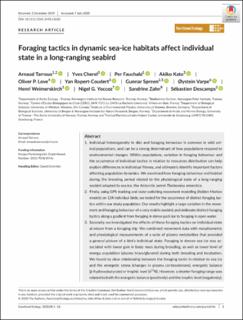Foraging tactics in dynamic sea-ice habitats affect individual state in a long-ranging seabird
Tarroux, Arnaud; Cherel, Yves; Fauchald, Per; Kato, Akiko; Love, Oliver P.; Ropert-Coudert, Yan; Spreen, Gunnar; Varpe, Øystein; Weimerskirch, Henri; Yoccoz, Nigel; Zahn, Sandrine; Descamps, Sebastien
Peer reviewed, Journal article
Published version

Åpne
Permanent lenke
https://hdl.handle.net/11250/2671516Utgivelsesdato
2020Metadata
Vis full innførselSamlinger
- Publikasjoner fra CRIStin - NINA [2364]
- Scientific publications [1392]
Originalversjon
10.1111/1365-2435.13632Sammendrag
1. Individual heterogeneity in diet and foraging behaviour is common in wild animal
populations, and can be a strong determinant of how populations respond to
environmental changes. Within populations, variation in foraging behaviour and
the occurrence of individual tactics in relation to resources distribution can help
explain differences in individual fitness, and ultimately identify important factors
affecting population dynamics. We examined how foraging behaviour and habitat
during the breeding period related to the physiological state of a long-ranging
seabird adapted to sea ice, the Antarctic petrel Thalassoica antarctica.
2. Firstly, using GPS tracking and state-switching movement modelling (hidden Markov
models) on 124 individual birds, we tested for the occurrence of distinct foraging tactics
within our study population. Our results highlight a large variation in the movement
and foraging behaviour of a very mobile seabird, and delineate distinct foraging
tactics along a gradient from foraging in dense pack ice to foraging in open water.
3. Secondly, we investigated the effects of these foraging tactics on individual state
at return from a foraging trip. We combined movement data with morphometric
and physiological measurements of a suite of plasma metabolites that provided
a general picture of a bird's individual state. Foraging in denser sea ice was associated
with lower gain in body mass during brooding, as well as lower level of
energy acquisition (plasma triacylglycerol) during both brooding and incubation.
We found no clear relationship between the foraging tactic in relation to sea ice
and the energetic stress (changes in plasma corticosterone), energetic balance
(β-hydroxybutyrate) or trophic level (δ15N). However, a shorter foraging range was
related to both the energetic balance (positively) and the trophic level (negatively).
4. Our results highlight a diverse range of foraging tactics in relation to sea ice in
Antarctic petrels. While the various foraging tactics do not seem to strongly
alter energetic balance, they may affect other aspects of Antarctic petrels'
physiology. Future changes in sea-ice habitats can thus be expected to have an
impact on the individual state of seabirds such as Antarctic petrels, which could
ultimately affect their population dynamics. Nonetheless, strong individual heterogeneity
in the use of sea-ice habitats by a typical pagophilic species might
strengthen its resilience to environmental changes and in particular to forecasted
sea-ice loss.
